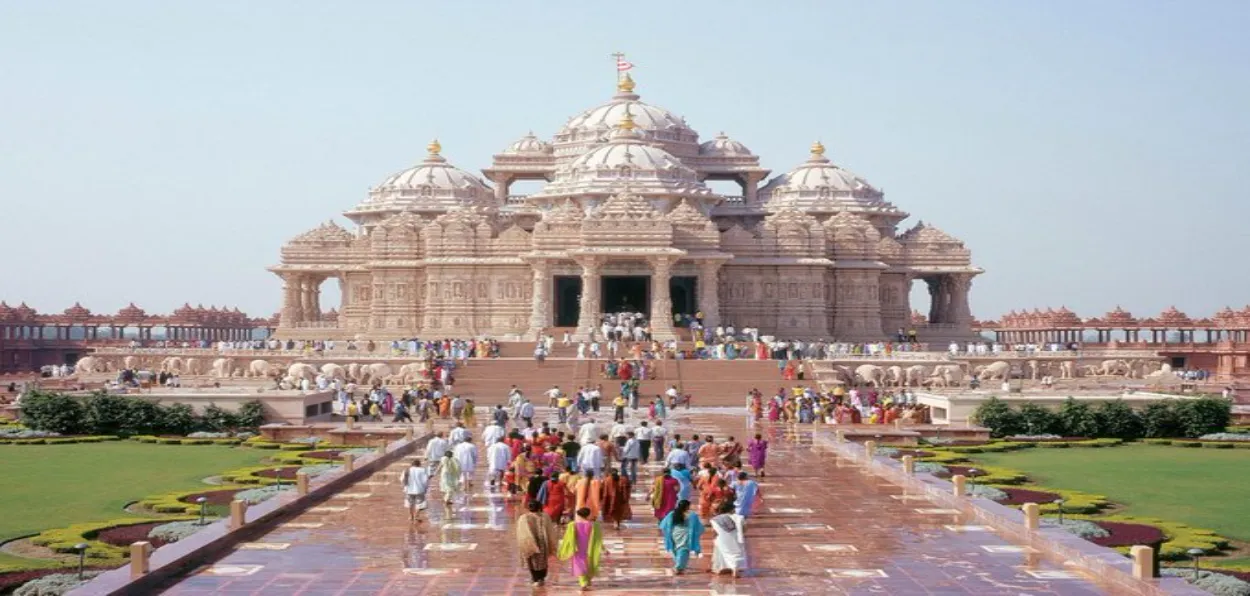
Ram Kumar Kaushik
After over four years of meticulous craftsmanship, the inaugural ceremony of Abu Dhabi's first Hindu temple is set to take place on February 14th, marking a historic moment of cultural harmony. Prime Minister Narendra Modi will lead the inauguration in a grand ceremony attended by dignitaries including Sheikh Mohamed, Mahant Swami Maharaj, and officials from India and the UAE. The event will feature rituals, prayers, cultural performances, and speeches, embodying the essence of unity and cooperation.
Here is all you want to know about Abu Dhabi’s first Hindu temple:
The BAPS Hindu Mandir in Abu Dhabi is not just a place of worship but a symbol of the UAE's commitment to tolerance and diversity. Designed to promote peace, harmony, and understanding, the temple aims to educate visitors about Hinduism's values of compassion, non-violence, and respect for all living beings. Through various cultural, educational, and humanitarian activities, it seeks to foster a deeper appreciation of Hindu culture and spirituality among people of all faiths.
Initiated in 2019 amidst the challenges posed by the COVID-19 pandemic, the temple's construction involved skilled artisans from Rajasthan and Gujarat who brought to life the grand vision of the temple. Situated on a 27-acre plot near Al Rahba, the temple boasts exquisite marble carvings crafted from over 25,000 stone pieces, showcasing architectural excellence. Designed by RSP Architects Planners & Engineers Private Limited and Capital Engineering Consultants, the temple draws inspiration from ancient Hindu scriptures, with its colossal structure set to become West Asia's largest Hindu temple.
Standing at 32.92 meters in height, 79.86 meters in length, and 54.86 meters in width, the temple features seven towers representing the seven emirates of the UAE. Within its intricate design are shrines narrating tales from Hindu epics such as the Ramayana and Mahabharata, adorned with depictions of deities including Venkateshwara, Swaminarayan, Jagannath, and Ayyappa.
One of the unique features of the mandir is the 'Dome of Harmony,' symbolizing the balance of the five natural elements – earth, water, fire, air, and space. This architectural marvel serves as a testament to the temple's commitment to promoting unity and understanding among diverse communities. Additionally, the complex offers a range of facilities including a visitor center, prayer halls, exhibitions, learning areas, children's sports facilities, thematic gardens, water features, a food court, and a books and gift shop.
News agency ANI has posted a video of the Temple which is being given final touches for inauguration on January 14:
Drone visuals of BAPS Hindu temple in Abu Dabhi to be inaugurated on 14th Feb by PM Modi.pic.twitter.com/a6grDNFEQY
— Shining Star 🇮🇳 (@ShineHamesha) December 29, 2023
The construction of the temple involved skilled artisans like Krashan Singh and Balram Tank, who expressed their pride and excitement in contributing to such a significant project. Hailing from generations of sculptors, they meticulously carved intricate designs using the finest white marble and pink sandstone, narrating stories from sacred scriptures. Their craftsmanship not only adds to the temple's aesthetic beauty but also preserves heritage for generations to come.
Krashan Singh, a third-generation sculptor from Makrana, expressed his excitement about contributing to the construction of a Hindu temple in Abu Dhabi. He said “I am a third-generation sculptor and we make designs by carving stones for a living. I was very excited about the idea of a Hindu temple in Abu Dhabi.
What better example to send than the message of brotherhood and communal harmony.”Balram Tank, a fifth-generation artisan, highlighted the significance of their craftsmanship in narrating the stories of sacred scriptures, expressing pride in their work being showcased for generations to come. “We have created intricate carvings using the finest white marble and pink sandstone that narrate stories from the holy scriptures. These elaborate pieces now serve as the centerpiece of the temple.”
ALSO READ: Farooq Nazki’s death brings to an end an era of Kashmiri literature
The idea for the temple originated from Pramukh Swami Maharaj's visit to the UAE in 1997, aiming to foster unity among nations and religions. His vision was realized through the UAE government's allocation of land for the temple in August 2015, a gesture of goodwill that strengthened the bond between India and the UAE. The foundation stone-laying ceremony in April 2019 marked the beginning of this remarkable endeavor, symbolizing a sacred space where humanity and harmony converge.
(Author is Delhi based Senior Journalist)
